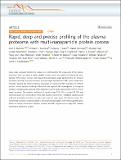Quantum interference device for controlled two-qubit operations
Author(s)
Loft, Niels Jakob Søe; Kjaergaard, Morten; Kristensen, Lasse Bjørn; Andersen, Christian Kraglund; Larsen, Thorvald W; Gustavsson, Simon; Oliver, William D; Zinner, Nikolaj T; ... Show more Show less
DownloadPublished version (4.090Mb)
Publisher with Creative Commons License
Publisher with Creative Commons License
Creative Commons Attribution
Terms of use
Metadata
Show full item recordAbstract
© 2020, The Author(s). Universal quantum computing relies on high-fidelity entangling operations. Here, we demonstrate that four coupled qubits can operate as a quantum gate, where two qubits control the operation on two target qubits (a four-qubit gate). This configuration can implement four different controlled two-qubit gates: two different entangling swap and phase operations, a phase operation distinguishing states of different parity, and the identity operation (idle quantum gate), where the choice of gate is set by the state of the control qubits. The device exploits quantum interference to control the operation on the target qubits by coupling them to each other via the control qubits. By connecting several four-qubit devices in a two-dimensional lattice, one can achieve a highly connected quantum computer. We consider an implementation of the four-qubit gate with superconducting qubits, using capacitively coupled qubits arranged in a diamond-shaped architecture.
Date issued
2020Department
Koch Institute for Integrative Cancer Research at MIT; Sloan School of Management; Massachusetts Institute of Technology. Operations Research CenterJournal
npj Quantum Information
Publisher
Springer Science and Business Media LLC